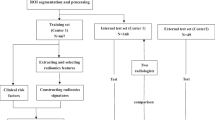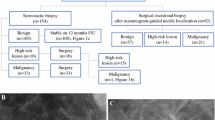Abstract
Purpose
We aimed to investigate the feasibility of predicting invasion carcinoma from ductal carcinoma in situ (DCIS) lesions diagnosed by preoperative core needle biopsy using radiomics signatures, clinical imaging characteristics, and breast imaging reporting and data system (BI-RADS) descriptors on mammography.
Methods
Retrospectively, we enrolled 362 DCIS patients diagnosed by core needle biopsy, 110 (30.4%) of which had invasive carcinoma confirmed by operation and pathology. We analyzed the images identified suspicious calcification from 250 subjects (161 pure DCIS and 89 DCIS with invasion). A total of 569 calcification radiomics signatures were extracted from microcalcification for each patient. We included a group of routine clinical imaging characteristics and BI-RADS descriptors for comparison purpose. Five feature selection and seven classification methods were evaluated in terms of their prediction performance. We compared the area under the receiver operating characteristic curve (AUC) averaged from tenfold cross-validation of different feature sets to identify the best combination of feature selection and classification methods.
Results
Optimal feature selection and classification methods were identified after evaluating various combinations of feature sets. The best performance was achieved using both radiomics and clinical imaging characteristics (AUC = 0.72) performing better than BI-RADS descriptors or radiomics, but was no significant difference with clinical imaging characteristics (AUC = 0.66). The most significant features found were morphology signatures, first-order statistics, asymmetry/mass prevalence, and nuclear grade.
Conclusions
We found that the prediction model established using microcalcifications radiomics signatures and clinical imaging characteristics has the potential to identify an understaging of invasive breast cancer.






Similar content being viewed by others
References
Fan L, Strasser-Weippl K, Li JJ, St Louis J, Finkelstein DM, Yu KD, Chen WQ, Shao ZM, Goss PE (2014) Breast cancer in China. Lancet Oncol 15(7):e279–e289. https://doi.org/10.1016/s1470-2045(13)70567-9
Cheng HD, Cai X, Chen X, Hu L, Lou X (2003) Computer-aided detection and classification of microcalcifications in mammograms: a survey. Pattern Recognit 36(12):2967–2991. https://doi.org/10.1016/S0031-3203(03)00192-4
Venkatesan A, Chu P, Kerlikowske K, Sickles EA, Smith-Bindman R (2009) Positive predictive value of specific mammographic findings according to reader and patient variables. Radiology 250(3):648–657. https://doi.org/10.1148/radiol.2503080541
Bijker N, Meijnen P, Peterse JL, Bogaerts J, Van Hoorebeeck I, Julien JP, Gennaro M, Rouanet P, Avril A, Fentiman IS, Bartelink H, Rutgers EJ (2006) Breast-conserving treatment with or without radiotherapy in ductal carcinoma-in situ: ten-year results of European Organisation for Research and Treatment of Cancer randomized phase III trial 10853—a study by the EORTC Breast Cancer Cooperative Group and EORTC Radiotherapy Group. J Clin Oncol 24(21):3381–3387. https://doi.org/10.1200/jco.2006.06.1366
Ernster VL, Ballard-Barbash R, Barlow WE, Zheng Y, Weaver DL, Cutter G, Yankaskas BC, Rosenberg R, Carney PA, Kerlikowske K, Taplin SH, Urban N, Geller BM (2002) Detection of ductal carcinoma in situ in women undergoing screening mammography. J Natl Cancer Inst 94(20):1546–1554
Macdonald HR, Silverstein MJ, Mabry H, Moorthy B, Ye W, Epstein MS, Holmes D, Silberman H, Lagios M (2005) Local control in ductal carcinoma in situ treated by excision alone: incremental benefit of larger margins. Am J Surg 190(4):521–525
Boughey JC, Gonzalez RJ, Bonner E, Kuerer HM (2007) Current treatment and clinical trial developments for ductal carcinoma in situ of the breast. Oncologist 12(11):1276–1287
Hermann G (2012) Ductal carcinoma in situ at core-needle biopsy: meta-analysis of underestimation and predictors of invasive breast cancer: Brennan ME, Turner RM, Ciatto S, et al (Univ. of Sydney, New South Wales, Australia) Radiology 260:119–128, 2011 §. Breast Dis Year Book Q 23(2):165–166
Menell JH, Morris EA, Dershaw DD, Abramson AF, Brogi E, Liberman L (2005) Determination of the presence and extent of pure ductal carcinoma in situ by mammography and magnetic resonance imaging. Breast J 11(6):382–390. https://doi.org/10.1111/j.1075-122X.2005.00121.x
Yi M, Krishnamurthy S, Kuerer HM, Meric-Bernstam F, Bedrosian I, Ross MI, Ames FC, Lucci A, Hwang RF, Hunt KK (2008) Role of primary tumor characteristics in predicting positive sentinel lymph nodes in patients with ductal carcinoma in situ or microinvasive breast cancer. Am J Surg 196(1):81–87. https://doi.org/10.1016/j.amjsurg.2007.08.057
Brennan ME, Turner RM, Ciatto S, Marinovich ML, French JR, Macaskill P, Houssami N (2011) Ductal carcinoma in situ at core-needle biopsy: meta-analysis of underestimation and predictors of invasive breast cancer. Radiology 260(1):119–128. https://doi.org/10.1148/radiol.11102368
Lee CH, Carter D, Philpotts LE, Couce ME, Horvath LJ, Lange RC, Tocino I (2000) Ductal carcinoma in situ diagnosed with stereotactic core needle biopsy: can invasion be predicted? Radiology 217(2):466
Bagnall MJ, Evans AJ, Wilson AR, Pinder SE, Denley H, Geraghty JG, Ellis IO (2001) Predicting invasion in mammographically detected microcalcification. Clin Radiol 56(10):828–832
Kurniawan ED, Rose A, Mou A, Buchanan M, Collins JP, Wong MH, Miller JA, Mann GB (2010) Risk factors for invasive breast cancer when core needle biopsy shows ductal carcinoma in situ. Arch Surg 145(11):1098–1104
Park HS, Kim HY, Park S, Kim EK, Kim SI, Park BW (2013) A nomogram for predicting underestimation of invasiveness in ductal carcinoma in situ diagnosed by preoperative needle biopsy. Breast 22(5):869–873
Sim YT, Litherland J, Lindsay E, Hendry P, Brauer K, Dobson H, Cordiner C, Gagliardi T, Smart L (2015) Upgrade of ductal carcinoma in situ on core biopsies to invasive disease at final surgery: a retrospective review across the Scottish Breast Screening Programme. Clin Radiol 70(5):502–506
Lee CW, Wu HK, Lai HW, Wu WP, Chen ST, Chen DR, Chen CJ, Kuo SJ (2016) Preoperative clinicopathologic factors and breast magnetic resonance imaging features can predict ductal carcinoma in situ with invasive components. Eur J Radiol 85(4):780–789
Dillon MF, McDermott EW, Quinn CM, O’Doherty A, O’Higgins N, Hill AD (2006) Predictors of invasive disease in breast cancer when core biopsy demonstrates DCIS only. J Surg Oncol 93(7):559–563. https://doi.org/10.1002/jso.20445
Park HS, Park S, Cho J, Park JM, Kim SI, Park B-W (2013) Risk predictors of underestimation and the need for sentinel node biopsy in patients diagnosed with ductal carcinoma in situ by preoperative needle biopsy. J Surg Oncol 107(4):388–392. https://doi.org/10.1002/jso.23273
Shi B, Grimm LJ, Mazurowski MA, Baker JA, Marks JR, King LM, Maley CC, Hwang ES, Lo JY (2018) Prediction of occult invasive disease in ductal carcinoma in situ using deep learning features. J Am Coll Radiol 15(3):527–534
Shi B, Grimm LJ, Mazurowski MA, Baker JA, Marks JR, King LM, Maley CC, Hwang ES, Lo JY (2017) Can occult invasive disease in ductal carcinoma in situ be predicted using computer-extracted mammographic features? Acad Radiol 24(9):1139–1147. https://doi.org/10.1016/j.acra.2017.03.013
Aerts HJWL, Velazquez ER, Leijenaar RTH, Parmar C, Grossmann P, Carvalho S, Bussink J, Monshouwer R, Haibe-Kains B, Rietveld D, Hoebers F, Rietbergen MM, Leemans CR, Dekker A, Quackenbush J, Gillies RJ, Lambin P (2014) Decoding tumour phenotype by noninvasive imaging using a quantitative radiomics approach. Nat Commun 5:4006. https://doi.org/10.1038/ncomms5006
Huang Y-Q, Liang C-H, He L, Tian J, Liang C-S, Chen X, Ma Z-L, Liu Z-Y (2016) Development and validation of a radiomics nomogram for preoperative prediction of lymph node metastasis in colorectal cancer. J Clin Oncol 34(18):2157–2164. https://doi.org/10.1200/JCO.2015.65.9128
Nakayama R, Uchiyama Y, Watanabe R, Katsuragawa S, Namba K, Doi K (2004) Computer-aided diagnosis scheme for histological classification of clustered microcalcifications on magnification mammograms. Med Phys 31(4):789–799
Nakayama R, Watanabe R, Namba K, Takeda K, Yamamoto K, Katsuragawa S, Doi K (2007) An improved computer-aided diagnosis scheme using the nearest neighbor criterion for determining histological classification of clustered microcalcifications. Methods Inf Med 46(06):716–722
Mohamed H, Mai SM, Sharawy A (2014) Computer aided detection system for micro calcifications in digital mammograms. Comput Methods Programs Biomed 116(3):226–235
Rangayyan RM, Ayres FJ, Leo Desautels JE (2007) A review of computer-aided diagnosis of breast cancer: toward the detection of subtle signs. J Frankl Inst 344(3):312–348. https://doi.org/10.1016/j.jfranklin.2006.09.003
Diaz-Huerta CC, Felipe-Riveron EM, Montaño-Zetina LM (2014) Quantitative analysis of morphological techniques for automatic classification of micro-calcifications in digitized mammograms. Expert Syst Appl 41(16):7361–7369
Strange H, Chen Z, Denton ERE, Zwiggelaar R (2014) Modelling mammographic microcalcification clusters using persistent mereotopology. Pattern Recognit Lett 47:157–163. https://doi.org/10.1016/j.patrec.2014.04.008
Nakayama R, Watanabe R, Namba K, Takeda K, Yamamoto K, Katsuragawa S, Doiya K (2006) Computer-aided diagnosis scheme for identifying histological classification of clustered microcalcifications by use of follow-up magnification mammograms. Acad Radiol 13(10):1219–1228. https://doi.org/10.1016/j.acra.2006.07.005
Parmar C, Grossmann P, Bussink J, Lambin P, Aerts HJWL (2015) Machine learning methods for quantitative radiomic biomarkers. Sci Rep 5:13087. https://doi.org/10.1038/srep13087
Parmar C, Grossmann P, Rietveld D, Rietbergen MM, Lambin P, Aerts HJWL (2015) Radiomic machine-learning classifiers for prognostic biomarkers of head and neck cancer. Front Oncol 5:272. https://doi.org/10.3389/fonc.2015.00272
Zhang B, He X, Ouyang F, Gu D, Dong Y, Zhang L, Mo X, Huang W, Tian J, Zhang S (2017) Radiomic machine-learning classifiers for prognostic biomarkers of advanced nasopharyngeal carcinoma. Cancer Lett 403:21–27. https://doi.org/10.1016/j.canlet.2017.06.004
Hawkins SH, Korecki JN, Balagurunathan Y, Gu Y, Kumar V, Basu S, Hall LO, Goldgof DB, Gatenby RA, Gillies RJ (2014) Predicting outcomes of nonsmall cell lung cancer using CT image features. IEEE Access 2:1418–1426. https://doi.org/10.1109/ACCESS.2014.2373335
Heinlein P, Drexl J, Schneider W (2003) Integrated wavelets for enhancement of microcalcifications in digital mammography. IEEE Trans Med Imaging 22(3):402–413. https://doi.org/10.1109/tmi.2003.809632
Alasadi AH, Al-Saedi AK (2017) A method for microcalcifications detection in breast mammograms. J Med Syst 41(4):68. https://doi.org/10.1007/s10916-017-0714-7
Chen Z, Strange H, Oliver A, Denton ER, Boggis C, Zwiggelaar R (2015) Topological modeling and classification of mammographic microcalcification clusters. IEEE Trans Biomed Eng 62(4):1203–1214. https://doi.org/10.1109/tbme.2014.2385102
Robin X, Turck N, Hainard A, Tiberti N, Lisacek F, Sanchez J-C, Müller M (2011) pROC: an open-source package for R and S+ to analyze and compare ROC curves. BMC Bioinform 12(1):77. https://doi.org/10.1186/1471-2105-12-77
Pedregosa F, Varoquaux G, Gramfort A, Michel V, Thirion B, Grisel O, Blondel M, Prettenhofer P, Weiss R, Dubourg V, Vanderplas J, Passos A, Cournapeau D, Brucher M, Perrot M, Duchesnay E (2011) Scikit-learn: machine learning in Python. J Mach Learn Res 12:2825–2830
Chen T, Guestrin C (2016) XGBoost: a scalable tree boosting system. https://doi.org/10.1145/2939672.2939785
de Mascarel I, MacGrogan G, Mathoulin-Pélissier S, Soubeyran I, Picot V, Coindre J-M (2002) Breast ductal carcinoma in situ with microinvasion: a definition supported by a long-term study of 1248 serially sectioned ductal carcinomas. Cancer 94(8):2134–2142. https://doi.org/10.1002/cncr.10451
Yu K-D, Wu L-M, Liu G-Y, Wu J, Di G-H, Shen Z-Z, Shao Z-M (2011) Different distribution of breast cancer subtypes in breast ductal carcinoma in situ (DCIS), DCIS with microinvasion, and DCIS with invasion component. Ann Surg Oncol 18(5):1342–1348. https://doi.org/10.1245/s10434-010-1407-3
Wang W, Zhu W, Du F, Luo Y, Xu B (2017) The demographic features, clinicopathological characteristics and cancer-specific outcomes for patients with microinvasive breast cancer: a SEER database analysis. Sci Rep 7:42045
Rauch GM, Hobbs BP, Kuerer HM, Scoggins ME, Benveniste AP, Park YM, Caudle AS, Fox PS, Smith BD, Adrada BE, Krishnamurthy S, Yang WT (2016) Microcalcifications in 1657 patients with pure ductal carcinoma in situ of the breast: correlation with clinical, histopathologic, biologic features, and local recurrence. Ann Surg Oncol 23(2):482–489. https://doi.org/10.1245/s10434-015-4876-6
Acknowledgements
This study was funded by the Science and Technology Planning Project of Guangdong Province, China (Nos. 2016B090918066, 201807010057), the Science and Technology Program of Guangzhou, China (No. 201704020060), the Health and Medical Collaborative Innovation Project of Guangzhou City (No. 201604020003), the National Natural Science Foundation of China (No. 61372141), Science and Technology Planning Project of Guangdong Province (No. 2016A010101013), and the Fundamental Research Fund for the Central Universities (No. 2017ZD051).
Author information
Authors and Affiliations
Corresponding author
Ethics declarations
Conflict of interest
The authors declare that they have no conflict of interest.
Ethical approval
All procedures performed in studies involving human participants were in accordance with the ethical standards of the institutional and/or national research committee and with the 1964 Declaration of Helsinki and its later amendments or comparable ethical standards. For this type of study, formal consent is not required.
Informed consent
Informed consent was obtained from all individuals included in the study.
Electronic supplementary material
Below is the link to the electronic supplementary material.
Rights and permissions
About this article
Cite this article
Li, J., Song, Y., Xu, S. et al. Predicting underestimation of ductal carcinoma in situ: a comparison between radiomics and conventional approaches. Int J CARS 14, 709–721 (2019). https://doi.org/10.1007/s11548-018-1900-x
Received:
Accepted:
Published:
Issue Date:
DOI: https://doi.org/10.1007/s11548-018-1900-x




